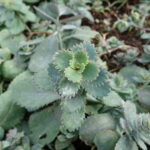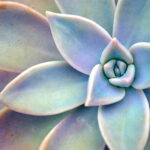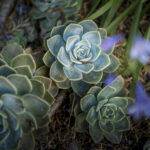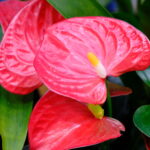Vibrant Red Succulents: A Stunning Addition to Your Garden
If you're looking to add a pop of color and uniqueness to your garden, vibrant red succulents are a perfect choice. These eye-catching plants are known for their bold and striking shades of red, which can range from deep burgundy to bright cherry. Succulents have gained popularity in recent years due to their low maintenance requirements and ability to thrive in various environments. With their stunning red hues, these succulents are sure to capture the attention of anyone who walks by.
We will explore the world of vibrant red succulents and discover the different varieties available. We will discuss the characteristics and care tips for these plants, including sunlight and water requirements, soil preferences, and propagation methods. Additionally, we will provide some creative ideas on how to incorporate these beautiful succulents into your garden or indoor space. Whether you're a seasoned gardener or a beginner, this article will inspire you to experiment with vibrant red succulents and transform your outdoor or indoor space into a colorful oasis.
- Choose succulent varieties with red or burgundy foliage for a vibrant addition to your garden
- Plant succulents in well-draining soil to prevent root rot and maintain their vibrant red color
- Place succulents in a location that receives ample sunlight to enhance their red pigmentation
- Water succulents sparingly to prevent overhydration, which can cause the red color to fade
- Use a balanced fertilizer to promote healthy growth and maintain the vibrancy of red succulents
- Consider planting red succulents in containers or raised beds to create a focal point in your garden
- Pair red succulents with plants that have contrasting colors to create a visually striking garden display
- Keep an eye out for pests and diseases that may affect the health and appearance of red succulents
- Prune red succulents regularly to maintain their shape and encourage new growth
- Enjoy the stunning beauty of your vibrant red succulents and showcase them to friends and family
- Frequently Asked Questions
Choose succulent varieties with red or burgundy foliage for a vibrant addition to your garden
Adding a pop of color to your garden can instantly transform it into a vibrant and eye-catching space. One way to achieve this is by incorporating succulents with red or burgundy foliage. These stunning plants not only add visual interest but also thrive in various growing conditions, making them a perfect choice for both beginners and experienced gardeners.
Why choose red succulents?
Red succulents are unique and captivating, standing out among the typical greenery found in most gardens. Their rich, deep hues create a striking contrast against other plants, making them a focal point in any landscape. Whether you are looking to create a dramatic desert-themed garden or simply want to add a touch of elegance to your existing flower beds, red succulents are an excellent choice.
Popular red succulent varieties
When it comes to red succulents, there are numerous varieties to choose from. Here are a few popular options:
- Echeveria 'Black Prince': This succulent features dark burgundy leaves that appear almost black in certain lighting conditions. Its rosette-shaped foliage adds a touch of elegance to any arrangement.
- Kalanchoe 'Flapjack': With its vibrant red and green foliage, this succulent is a showstopper. Its leaves are thick and paddle-shaped, resembling the shape of a pancake, hence the name "Flapjack."
- Sedum 'Dragon's Blood': This low-growing succulent has deep red leaves that turn even more intense during the cooler months. Its small, star-shaped flowers add an additional splash of color to your garden.
Care tips for red succulents
While red succulents may require a bit more attention compared to their green counterparts, they are still relatively easy to care for. Here are some essential care tips:
- Light: Red succulents thrive in bright, indirect sunlight. Place them in a location with at least six hours of sunlight per day.
- Water: Allow the soil to dry out between waterings to prevent root rot. Overwatering can be detrimental to the health of your succulents.
- Soil: Use well-draining soil specifically formulated for succulents. This prevents excess moisture and ensures proper root development.
- Temperature: Most red succulents prefer moderate temperatures, around 60-75°F (15-24°C). Protect them from extreme heat or cold.
- Propagation: Red succulents can be propagated through stem or leaf cuttings. This allows you to expand your collection or share these stunning plants with others.
By choosing red succulents for your garden, you are adding a touch of boldness and elegance to your outdoor space. Whether used as standalone plants or combined with other succulent varieties, their vibrant colors are sure to make a statement. So, why not introduce these eye-catching plants into your garden and enjoy the beauty they bring?
 Exploring the Diversity: Various Succulent Types in My Collection
Exploring the Diversity: Various Succulent Types in My CollectionPlant succulents in well-draining soil to prevent root rot and maintain their vibrant red color
Succulents are a popular choice for garden enthusiasts due to their unique shapes, low maintenance requirements, and wide array of colors. One of the most eye-catching variations is the vibrant red succulent. These stunning plants can add a pop of color and visual interest to any garden or indoor space.
To ensure that your vibrant red succulents thrive and maintain their striking color, it is crucial to plant them in well-draining soil. Succulents have shallow root systems that are prone to rotting if they are constantly exposed to excess moisture. By using well-draining soil, you can prevent water from pooling around the roots and protect your plants from root rot.
When choosing soil for your red succulents, opt for a mix specifically formulated for succulent plants. These mixes usually contain a combination of sand, perlite, and peat moss, which provide excellent drainage and aeration for the roots.
Water your vibrant red succulents sparingly and allow the soil to dry out between waterings
While succulents are known for their ability to store water in their leaves, it is still important to water them properly to maintain their vibrant red color. Overwatering can lead to root rot and can cause the plant to lose its vibrant hue.
Instead, water your red succulents sparingly. Allow the soil to dry out completely between waterings, and only water them when the top inch of soil feels dry to the touch. This will help ensure that your succulents stay healthy and vibrant.
Provide your vibrant red succulents with adequate sunlight
Succulents thrive in bright, indirect sunlight. For vibrant red succulents, it is essential to provide them with enough light to maintain their vivid color. Place your succulents in a location where they can receive at least six hours of sunlight per day.
 Find Long-Stemmed Succulents: Discover Elongated Varieties
Find Long-Stemmed Succulents: Discover Elongated VarietiesIf you are growing your red succulents indoors, place them near a south-facing window or use artificial grow lights to supplement the natural light. Be cautious not to expose them to direct sunlight for extended periods, as this can cause sunburn and damage the leaves.
Fertilize your red succulents sparingly
While succulents generally do not require frequent fertilization, providing them with a balanced, low-nitrogen fertilizer can help enhance their vibrant red color. However, it is crucial to fertilize sparingly, as over-fertilization can lead to excessive growth and dilute the intensity of the red pigmentation.
Use a diluted succulent fertilizer once every two to three months during the growing season. Follow the instructions on the fertilizer package and avoid applying it to dry soil.
Protect your vibrant red succulents from extreme temperatures
Vibrant red succulents are generally more sensitive to extreme temperatures than other succulent varieties. They may lose their intense color if exposed to excessive heat or cold. During hot summer months, provide shade or move your succulents to a cooler area to shield them from scorching sunlight.
In colder climates, it is advisable to bring your red succulents indoors or provide them with a protective covering during frosty nights. This will help preserve their vibrant color and prevent any damage caused by freezing temperatures.
By following these care tips, you can ensure that your vibrant red succulents remain a stunning addition to your garden. Their vivid color and unique appearance will undoubtedly catch the eye of any visitor and bring a touch of beauty to your outdoor space.
Place succulents in a location that receives ample sunlight to enhance their red pigmentation
One of the key factors in achieving vibrant red succulents is to ensure they receive enough sunlight. Succulents, like many other plants, rely on sunlight to produce pigments that give them their vibrant colors. So, it's important to choose a location in your garden that gets plenty of direct sunlight.
 Thriving Potential: Indoor Varieties of Tall Red Succulents
Thriving Potential: Indoor Varieties of Tall Red SucculentsSucculents are naturally adapted to thrive in bright and sunny conditions, so providing them with at least 6 hours of direct sunlight per day is ideal. Placing them in a spot where they can soak up the sun's rays will help intensify their red pigmentation and keep them looking their best.
However, it's worth noting that not all succulents require the same amount of sunlight. Some varieties, like Echeverias and Sedums, can tolerate more shade and still maintain their red hues. On the other hand, sun-loving succulents such as Crassulas and Kalanchoes need full sun exposure to develop their intense red colors.
Tip: If you live in an area with limited sunlight or have a shaded garden, you can still grow red succulents successfully by choosing varieties that are known for their ability to retain their red pigmentation in lower light conditions. Some examples include Haworthias and Gasterias.
Remember to regularly monitor your succulents' sun exposure and adjust their location accordingly. If you notice their red color fading or the leaves stretching towards the light, it's a sign they need more sunlight. On the other hand, if the leaves start to turn brown or become sunburned, it's an indication that they are getting too much direct sunlight and need some shade.
Water succulents sparingly to prevent overhydration, which can cause the red color to fade
Watering Tips for Vibrant Red Succulents
Succulents are known for their ability to store water in their leaves, making them resilient and low-maintenance plants. However, when it comes to vibrant red succulents, it's important to water them sparingly to prevent overhydration, which can cause the red color to fade.
Here are some watering tips to keep your vibrant red succulents looking their best:
 Discover the Best Blooming Succulents for Ground Covers
Discover the Best Blooming Succulents for Ground Covers- Allow the soil to dry out completely between waterings: Succulents prefer dry conditions, so make sure the soil is completely dry before watering them again. Stick your finger about an inch into the soil to check for moisture. If it feels dry, it's time to water.
- Water deeply but infrequently: When you do water your succulents, give them a good soak. Water deeply until you see the excess water draining out from the bottom of the pot. However, make sure not to water them too often. Aim for watering once every 1-2 weeks, depending on the climate and humidity level.
- Avoid overhead watering: Watering from above can lead to water sitting in the leaves, which can cause rot and damage the vibrant red color. Instead, water directly at the base of the plant, allowing the water to reach the roots.
- Use well-draining soil: Succulents need soil that allows excess water to drain quickly. Consider using a specialized succulent potting mix or adding perlite or sand to regular potting soil to improve drainage.
- Adjust watering based on the season: Succulents may require more frequent watering during the hot summer months and less during the cooler winter months when their growth slows down. Monitor the moisture levels and adjust your watering schedule accordingly.
By following these watering tips, you can help your vibrant red succulents thrive and maintain their stunning color. Remember, less is more when it comes to watering succulents, so be mindful of their water needs and enjoy the beauty they bring to your garden.
Use a balanced fertilizer to promote healthy growth and maintain the vibrancy of red succulents
When it comes to growing vibrant red succulents in your garden, one of the key factors to consider is the type of fertilizer you use. A balanced fertilizer can play a crucial role in promoting healthy growth and maintaining the stunning red color of these plants.
First and foremost, it's important to understand what a balanced fertilizer is. Essentially, it contains a mix of essential nutrients, including nitrogen, phosphorus, and potassium, in a well-balanced ratio. These nutrients are essential for the overall health and development of succulents, and they directly impact their coloration.
Nitrogen: This nutrient is responsible for promoting lush, green foliage. While it is necessary for succulent growth, an excess of nitrogen can lead to excessive leaf growth, which can dilute the intensity of the red color. Therefore, it's important to choose a balanced fertilizer with a moderate amount of nitrogen to avoid overwhelming the red pigmentation.
Phosphorus: This nutrient is crucial for root development and overall plant health. It aids in the transfer of energy throughout the succulent, enabling it to grow strong and vibrant. Additionally, phosphorus plays a vital role in enhancing flower production, which can further enhance the visual appeal of your red succulents.
Potassium: Also known as potash, potassium is essential for succulents as it improves their overall tolerance to stress, disease resistance, and water regulation. It plays a vital role in maintaining the red coloration of succulents, enhancing their vibrancy, and preventing any discoloration or fading that may occur due to environmental factors.
 Discover the Stunning Succulents with Towering Blossoms
Discover the Stunning Succulents with Towering BlossomsWhen selecting a balanced fertilizer for your red succulents, consider opting for a slow-release formulation. This type of fertilizer gradually releases nutrients over an extended period, ensuring a steady supply for the plants without the risk of nutrient burn.
Additionally, it's crucial to follow the manufacturer's instructions when applying the fertilizer. Over-fertilizing can lead to nutrient imbalances, which can harm your succulents and negatively impact their coloration. Remember, moderation is key when it comes to fertilizing red succulents.
Using a balanced fertilizer is essential for promoting healthy growth and maintaining the vibrant red color of succulents. By providing the right nutrients in the proper amounts, you can ensure that your red succulents thrive and become a stunning addition to your garden.
Consider planting red succulents in containers or raised beds to create a focal point in your garden
Red succulents are a vibrant and visually striking addition to any garden. Whether you have a small balcony, a spacious backyard, or a rooftop garden, planting red succulents in containers or raised beds can create a stunning focal point that will surely catch the eye of anyone who sees it.
Why choose red succulents?
While green succulents are commonly found in gardens, red succulents add a unique and captivating element to the overall aesthetic. The deep red hues of these plants can range from burgundy to crimson, adding a touch of drama and sophistication to your garden.
Moreover, red succulents are not only visually appealing but also incredibly versatile. They can be easily incorporated into various garden styles, such as modern, tropical, or even desert-themed gardens. Their bold color can complement other plants and flowers or stand out as a striking focal point on its own.
 Top Blue-Green Succulents: Enhance Your Collection
Top Blue-Green Succulents: Enhance Your CollectionPopular red succulents to consider
- Red Aeonium: This succulent features rosettes of deep burgundy leaves that create a stunning contrast against its yellow flowers.
- Red Echeveria: With its rosettes of red or burgundy leaves, this succulent adds a pop of color to any arrangement or garden bed.
- Red Sedum: This low-growing succulent displays clusters of red or reddish-purple leaves, making it an excellent groundcover option.
Tips for growing red succulents
- Well-draining soil: Red succulents prefer soil that drains well, as excessive moisture can lead to root rot. Consider adding perlite or sand to improve drainage.
- Plenty of sunlight: Most red succulents thrive in bright sunlight. Ensure they receive at least six hours of direct sunlight each day.
- Watering: While succulents are known for their ability to tolerate drought, they still require watering. Water your red succulents thoroughly but allow the soil to dry out between waterings to prevent overwatering.
- Protection from frost: Red succulents are generally more cold-sensitive than their green counterparts. If you live in a colder climate, provide frost protection during winter months.
Incorporating red succulents into your garden can instantly elevate its visual appeal and create a captivating focal point. Their stunning color, versatility, and easy care make them an excellent choice for both beginner and experienced gardeners. So why not add some vibrant red succulents to your garden and enjoy their beauty year-round?
Pair red succulents with plants that have contrasting colors to create a visually striking garden display
If you're looking to add a pop of color to your garden, vibrant red succulents are an excellent choice. Their striking hue can instantly catch the eye and create a visually stunning display. To make the most of these beautiful plants, consider pairing them with other plants that have contrasting colors.
Contrasting Colors for a Striking Garden Display
When it comes to creating a visually appealing garden, contrasting colors play a crucial role. By combining red succulents with plants that have different hues, you can achieve a captivating and dynamic garden design. Here are a few color combinations that work well with red succulents:
- Green and Red: The classic combination of green and red creates a vibrant and energetic contrast. Pairing red succulents with green foliage can make both colors stand out and create a visually striking effect.
- Purple and Red: For a more dramatic look, consider pairing red succulents with plants that have purple flowers or foliage. The deep tones of purple can intensify the vibrancy of the red succulents and create a captivating contrast.
- Yellow and Red: If you want to create a bold and eye-catching display, combine red succulents with plants that have yellow flowers or foliage. The contrasting colors of red and yellow can create a striking visual impact and add a cheerful touch to your garden.
- Blue and Red: For a unique and unexpected combination, consider pairing red succulents with plants that have blue flowers or foliage. The cool tones of blue can provide a striking contrast to the warmth of the red succulents, creating a visually pleasing and harmonious display.
By incorporating these contrasting colors into your garden design, you can create a visually stunning display that showcases the vibrant beauty of red succulents. Whether you prefer a bold and energetic look or a more dramatic and sophisticated style, the combination of red succulents with contrasting plants is sure to make a statement in your garden.
Keep an eye out for pests and diseases that may affect the health and appearance of red succulents
While red succulents are known for their striking and vibrant color, it is important to be aware of potential pests and diseases that can impact their health and appearance. By being vigilant and taking proactive measures, you can ensure that your red succulents thrive in your garden.
 The Fascinating World of Blooming Succulents: Unveiled
The Fascinating World of Blooming Succulents: UnveiledPests to watch out for:
- Aphids: These small insects are a common pest for succulents. They feed on the sap of the plants, causing leaves to shrivel and distort. Keep an eye out for clusters of tiny, green or black insects on your red succulents.
- Mealybugs: Mealybugs are another common pest that can target red succulents. They appear as small, white, cotton-like masses on the leaves and stems. Mealybugs can cause stunted growth and yellowing of the foliage if left untreated.
- Spider mites: These tiny pests are difficult to spot but can cause significant damage to red succulents. They feed on the plant's fluids, resulting in webbing, discoloration, and eventual leaf drop.
- Scale insects: Scale insects can be a problem for red succulents, especially if they are grown indoors. They appear as brown or tan bumps on the leaves and stems and can cause wilting and yellowing of the foliage.
Common diseases affecting red succulents:
- Root rot: Overwatering or poor drainage can lead to root rot in red succulents. This disease causes the roots to become mushy and black, eventually leading to wilting and death of the plant.
- Fungal infections: Red succulents are susceptible to fungal infections, especially in humid environments. Common fungal diseases include powdery mildew and leaf spot, which can cause blemishes and discoloration on the leaves.
- Viral infections: Viral infections can affect the overall health and appearance of red succulents. Symptoms may include stunted growth, yellowing, and distortion of the leaves. Unfortunately, there is no cure for viral infections, and infected plants should be removed to prevent the spread to other succulents.
To prevent and control pests and diseases, it is important to maintain good garden hygiene. Regularly inspect your red succulents for any signs of pests or diseases and take appropriate action if necessary. Avoid overwatering and ensure proper drainage to prevent root rot. Additionally, provide adequate air circulation and avoid overcrowding of plants to minimize the risk of fungal infections.
By staying vigilant and implementing proper care practices, you can enjoy the vibrant beauty of red succulents in your garden for years to come.
Prune red succulents regularly to maintain their shape and encourage new growth
Succulents are known for their unique and eye-catching colors, and red succulents are no exception. With their vibrant hues, these plants can add a stunning pop of color to any garden or indoor space. However, it's important to remember that red succulents require proper care and maintenance to keep them looking their best.
 Guide to Rare Pink Succulents with Butterfly-Shaped Leaves
Guide to Rare Pink Succulents with Butterfly-Shaped LeavesOne crucial aspect of caring for red succulents is regular pruning. Pruning not only helps to maintain their desired shape but also stimulates new growth, ensuring that your succulents stay healthy and vibrant.
Why prune red succulents?
Pruning red succulents serves several purposes. Firstly, it helps to remove any dead or damaged foliage, keeping the plant looking neat and tidy. This also prevents the spread of diseases or pests that may be present on the affected leaves. Secondly, pruning can help control the size of the succulent, preventing it from becoming too large or leggy.
Additionally, pruning stimulates new growth by encouraging the succulent to produce more branches and leaves. This leads to a fuller and more lush appearance, enhancing the overall beauty of the plant.
When to prune red succulents?
 Rare Succulent Collection: Unique Cacti & Pineapple Varieties
Rare Succulent Collection: Unique Cacti & Pineapple VarietiesThe best time to prune red succulents is during their active growing season, which is typically in spring or early summer. During this time, the plants are actively producing new growth, making it easier for them to recover from pruning.
However, it's important to note that not all succulents have the same pruning requirements. Some varieties may require more frequent pruning while others may need less. It's always a good idea to research the specific care guidelines for your particular red succulent to ensure you're pruning it at the right time.
How to prune red succulents?
Pruning red succulents is a relatively simple process. Start by inspecting the plant and identifying any dead or damaged leaves or branches. Using a pair of clean and sharp pruning shears, carefully remove these unwanted parts, making sure to make clean cuts to avoid damaging the healthy portions of the plant.
When pruning, it's also important to consider the shape and size you want your red succulents to have. If you prefer a more compact appearance, prune the succulent by cutting back its branches and removing any leggy growth. On the other hand, if you want a more sprawling and cascading look, you can prune the plant to encourage it to grow in a fuller and more spreading manner.
Remember to always wear gloves when handling succulents, as some varieties may have sharp spines or thorns that can cause injury.
 Discover the Stunning Flowering Succulents that Transform Gardens
Discover the Stunning Flowering Succulents that Transform GardensPruning red succulents is essential for their overall health and appearance. By regularly removing dead or damaged foliage, controlling their size, and encouraging new growth, you can ensure that your red succulents remain vibrant and stunning additions to your garden or indoor space.
Enjoy the stunning beauty of your vibrant red succulents and showcase them to friends and family
Adding vibrant red succulents to your garden can instantly transform it into a visually striking and eye-catching paradise. These unique plants not only add a pop of color to your outdoor space but also require minimal maintenance, making them a perfect addition for both seasoned gardeners and beginners.
With their vibrant hues and distinctive shapes, red succulents effortlessly draw attention and create a focal point in any garden. Whether you choose to display them in pots, rock gardens, or as ground cover, these plants are sure to make a statement.
Why choose red succulents?
Red succulents are known for their ability to add a touch of drama and intensity to any garden. Their deep red, burgundy, or even purple tones create a visual contrast against green foliage, making them stand out from the crowd. These plants can also complement other succulents with different colors, creating a stunning color palette that adds depth and interest to your garden.
Moreover, red succulents are often drought-tolerant and can thrive in various climates. Their unique ability to store water in their leaves allows them to withstand dry conditions, making them a resilient option for areas with limited rainfall or for those who prefer low-maintenance plants.
How to showcase your vibrant red succulents
There are several creative ways to showcase your vibrant red succulents and make them the star of your garden:
- Container Gardens: Plant your red succulents in colorful pots or containers and arrange them in clusters or as standalone pieces. This allows you to easily move them around and create different arrangements depending on your mood and the season.
- Rock Gardens: Incorporate your red succulents into a rock garden for a striking contrast. The combination of the vibrant red hues and the rugged textures of rocks creates a visually appealing and natural-looking display.
- Ground Cover: Plant red succulents as ground cover to create a carpet of vibrant color. This option is ideal for larger areas or slopes where you want to make a bold statement.
Remember to consider the growth habits and requirements of your red succulents when deciding on the best way to showcase them. Some varieties may grow tall and leggy, while others may stay compact and low to the ground. Understanding these characteristics will help you design a visually pleasing and well-balanced garden.
Introducing vibrant red succulents to your garden is an excellent way to add a touch of drama and visual interest. Their unique colors, low-maintenance nature, and ability to thrive in various conditions make them a valuable addition to any outdoor space. Whether you choose to display them in pots, rock gardens, or as ground cover, these stunning plants are sure to impress your friends and family and turn your garden into a vibrant oasis.
Frequently Asked Questions
1. Can succulents be red?
Yes, there are several succulent varieties that come in vibrant shades of red.
2. How do red succulents get their color?
Red succulents get their color from pigments called anthocyanins, which are produced in response to various environmental factors.
3. Are red succulents difficult to care for?
No, red succulents have similar care requirements as other succulents. They need well-draining soil, adequate sunlight, and infrequent watering.
4. Can red succulents survive in different climates?
Yes, red succulents can adapt to different climates, but it's important to choose varieties that are suitable for your specific climate conditions.
